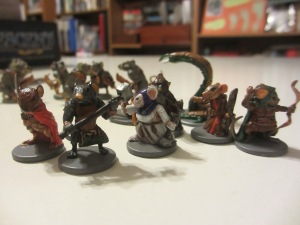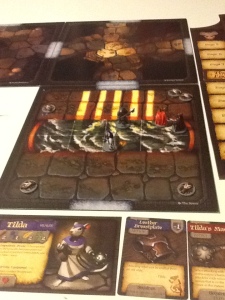
Since I got my mice painted, I needed to put them to good use. My oldest son (6 years old) has been begging to play with my minis for a while, and he’s smart, so I figured the 7+ age recommendation on the game was in his range. My wife was also interested in seeing how the game worked, so the family (minus the 3 year old, who only wandered in to roll dice every once in a while) sat down to play. It helps that the game is cooperative, so we don’t have to compete with each other.
Mice & Mystics was designed by Jerry Hawthorne and published by Plaid Hat Games. It comes in a hefty box with a bunch of square board tiles representing the rooms of the castle; cards for events, items, skills, and characters; minis representing the heroic mice and their enemies; some cardboard counters for tracking health, time, and cheese; and some custom dice for resolving actions. The overall style of the design is what I would call “realism cartoon”–the board tiles are mostly dark-toned and project a gritty kind of medieval world, and the characters are drawn heroically–more in the style of Mouse Guard than Mickey.
The story of M&M tells us that all of the mice were once humans who were imprisoned by an evil queen. In order to escape their prison and fight back against the tyrant queen, they used magic to turn themselves into mice–inadvertently turning many of their captors into rats. The “campaign” mode of the game tells the story of the attempts by the mice to rescue their kingdom. There are multiple scenarios to the campaign, with each one telling one small part of the mousey revolution. Each scenario details which board sections to use and what special rules apply to each room. It also has a narrative that fills in the story of the mice–a particularly nice touch, especially given that the writing evokes the heroic feel of the game and the whimsy of playing revolutionary mice.

Game play is pretty simple. Each player controls one or more mice–depending on the chapter and the number of players. Each mouse follows a typical fantasy type–warrior, thief, healer, wizard, ranger. You set up the initial board and deal cards to see in what order the mice (and their enemies) take their actions. On each mouse’s turn, the player gets to move the mouse (roll 1 die and add its number to the Paw/Movement attribute on the mouse’s character card). Before or after that move, the player gets to take one action–search for loot, attack a bad guy, move again, use an ability, etc. When you take an action, you roll a number of dice equal to the mouse’s relevant attribute (his Sword skill to attack, her Shield skill to defend, etc.) The dice have different symbols on them–number, swords, shields, stars, and cheese. Your skills and actions tell you what you want to roll, but this is mostly obvious. I.e when attacking, you want to roll swords; when defending you want to roll shields. When attacking or defending with your mouse, you usually want to roll cheese, too. (Cheese acts as experience points and energy. You can use cheese to power some of the mouse’s skills or save your cheese to buy new skills.)
Since the game is cooperative, the bad guys have rules that define how they act. Usually this means that they move to attack the nearest mouse, or if there are multiple mice at the same distance, they attack the one highest in the initiative order. A big part of the game play is setting up who can deal the most damage to the bad guys and who can soak their attacks in return. When the bad guys attack and defend, any cheese they roll gets added to a clock on the game board. When the clock fills up with cheese, they get some reinforcements, and time advances one “chapter.” Each scenario only has so many chapters, and if you run out of chapters, your mice lose that scenario. Your mice win if they can complete the objectives of the scenario. (In the first scenario, the objective is to escape from the castle, but there’s an optional side quest to get the castle cook on your side.)
There are some other rules, mainly explaining what happens with special bad guys (like the castle’s cat), terrain effects (water, high tables, etc.), or special equipment (like a grape-a-pult you can make if you find a fork and a grape).
So far, we’ve played the opening scenario twice. The first time we tried to help the cook and wound up too weak to get out of the castle before we ran out of time. The second time, we ignored the cook’s pleas (which may have repercussions for us in a later chapter), but we got out of the castle and found the camp of some other mice in a tree in the courtyard.
So far, we love this game. It’s the first game in a long while that has my wife asking when we can play again. The narrative of the campaign is part of the draw; we all want to find out what happens in the next scenario and whether our mice will prevail and save the kingdom. But we also like the quick game play–with some experience, you can probably play one scenario in about an hour, which is coincidentally about the limit on the attention span of our 6 year old. (In our first play, the game took a bit longer as we looked up rules and made sure we got things right. In the second play, the game moved significantly faster.) To be clear, though, this is not just a children’s game. It offers similar decision-making to other cooperative games like Pandemic and most of the skills and character abilities require a fair bit of reading comprehension. While the game box says ages 7+, I think a group of average seven-year-olds would have a hard time figuring this game out by themselves. Our son likes playing the game with us, but if left to his own devices, he would probably just make up his own game with the components.
I’ve seen some comments online that fault this game for being a bad dungeon crawl game, but I think that’s a case of misapplying one’s expectations. I went into this game expecting a cooperative game, not a dungeon crawler, and my expectations weren’t shattered. There’s a certain “dungeon” aspect to the game–your characters “level up,” the game has a campaign mode, you fight monsters, etc. But the heart of the game is about time and resource management–do you risk searching for loot when there’s a chance that more bad guys will arrive and move the time closer to ending the game? A more accurate concern might be the amount of randomness created by the dice rolls and card draws. Conceivably, you could have the cheese clock fill up in just one round of bad guy actions. But you could just as conceivably never have the cheese clock advance. The luck factor felt balanced in our plays, and we blamed (or praised) our own decisions, not the dice.
The only real complaint I have with the game is the number of dice in the box. The game comes with 5 dice, but even in the first scenario, we found situations where we were rolling 4 dice to attack and needed 4 dice to defend. The game would move faster if the player rolling defense could roll at the same time as the attacking player, instead of having to wait for the dice to be re-collected and passed around the table. (Although, to be fair, my son likes to hoard dice, so the dice don’t really remain out in the general play area.)
But the number of dice is a minor quibble in an otherwise awesome game. I’m not sure how much replay the game will have after we beat all eleven of the scenarios, but if it takes us a couple of tries to beat each scenario, we’re looking at 20+ plays before we’re “done” with the game, and that’s pretty good value for the money. By then, there might even be an expansion!
Some extra links:
- An interview with the designer by Board Game Muse.
- A review by Josh Edwards.
- A review from No High Scores.
- A review from Drake’s Flames.
Great review. This sounds like a fun gateway game for kids. I may have to pick up a copy for the nephews in a few years.
Thanks. I think it could be a fun gateway game. But don’t let the mice-theme fool you; it’s a lot of fun as an adult, too.
Nice review, thanks.